Located on the banks of the Mun River, in the lower part of northeastern Thailand, Ubon Ratchathani is a large area, the capital of the province, dubbed the lotus city with two beautiful rivers, charming beaches and rapids, Thai tradition culture and Buddhism. Ubon Ratchathani was founded about 200 years ago. In 1780, King Taksin officially applied the law to this area and named the city as it is today. The city was a semi-autonomous region until 1882 when it was appointed a separate government as an area of King Siam.
About 629km from Bangkok, Ubon Ratchathani province stands out with its highland terrain and mountain ranges overlapping with the Mun River. Sandstone cliffs along the Mekong mark the border between Thailand and Laos. The area where the Ubon Ratchathani, borders of Cambodia and Lao and the Mekong line creates the Golden Triangle area, a green area with a poetic, beautiful and romantic scene. In addition, Ubon Ratchathani has two attractive nature reserves called Phu Chong Nayoi and Pha Taem National Parks. Every year, there has a candle festival, a beautiful romantic Buddhist festival.
A lot of visitors choose to start their Ubon Ratchathani visit from Bangkok since the transportations connecting two areas are quite convenient. The journey could also bring you into a new world escapes from the hustle and bustle Bangkok.
By car: Ubon Ratchanthani is connected with Bangkok by high way. The journey would be about 629 kilometers long.
By train: There are daily trains from Hua Lamphong station to Ubon Ratchathani.
The most famous attractions:
Visit Ubon Ratchathani province, you can refer to the outstanding attractions such as Thung Si Meuang Park, Wat Thung Si Meuang Temple, National Museum...
Thung Si Meuang Park:
Located in the city center that hosts the Big Candle Festival. The Merit Monument is in the northeast corner built of small bricks by prisoners during World War 2 to honor the Udon people during the Japanese occupation. This is also the park where local people relax and do exercise. When the sun goes down, people gather in Thung Si Muang to jog and do exercise, play basketball, dance and do aerobics. On weekend evening, the atmosphere is more exciting and crowded by the shop of clothing on the 2 sides of the road.
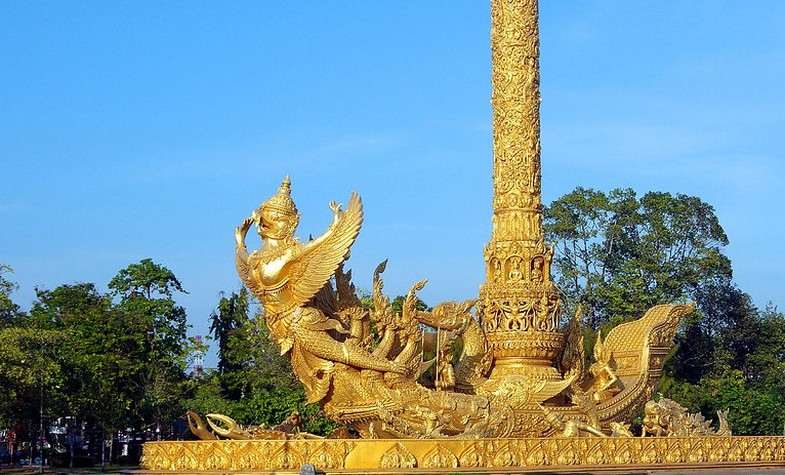
Thung Si Meuang Park Wing of Victory
Wat Thung Si Meuang Temple:
Built during the reign of King Rama III (1824 - 1851) to preserve a copy of Buddha's footprint. The architecture here is a mix of Lao style and rattankosin. Wat Thung Si Meuang has beautiful architecture with a classical pedestrian hall. The most beautiful structure in the temple is probably the wooden Tripitaka Library (Ho Trai) designed to sit on the floor in the middle of the lake to prevent materials from insects (ants and termites).
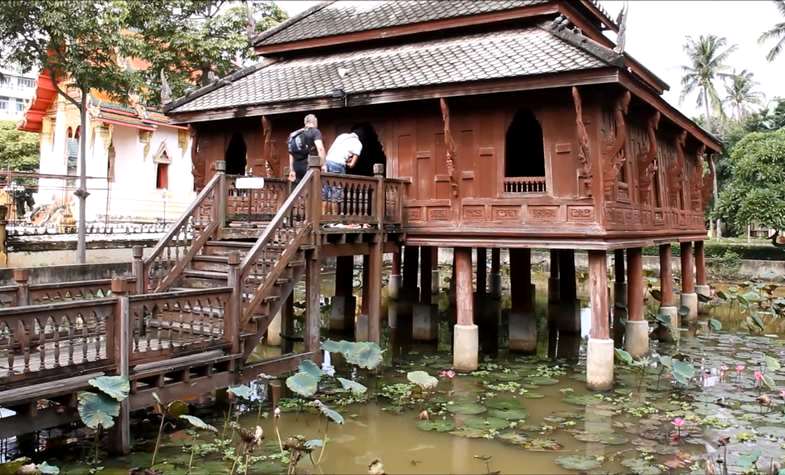
Wat Thung Si Meuang Temple
Ubon Ratchathani National Museum:
Located in Kheuan Thani Street, opening hours: 9am - 4pm from Wednesday to Sunday, Ubon Ratchathani National Museum is a beautiful European-style building built in 1918. Originally, this was the town hall of Ubon city. It was not until 1983 that this building was converted into a national museum. The museum building has a cream-colored exterior with green shutters commonly found in colonial buildings of Southeast Asia. The floors are parquet and the corridors are winding, leading to a small garden in the center. Tourists will start to visit from the left gate and gradually go deeper inside.
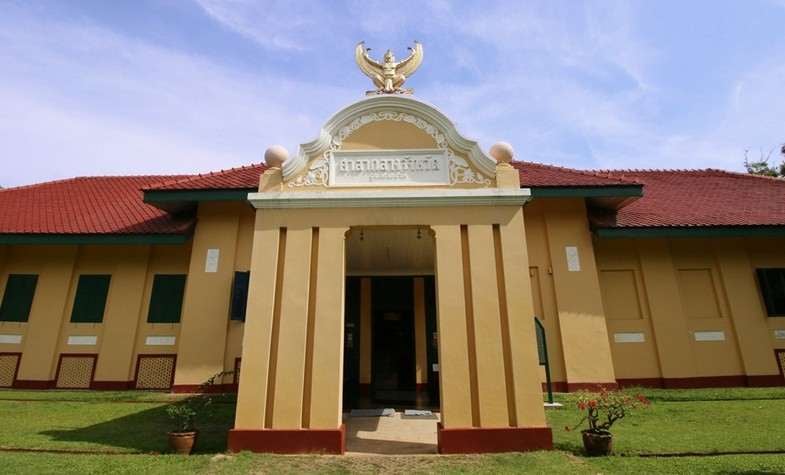
Ubon Ratchathani National Museum
The museum exhibits begin with the geography and geology collection of the Isaan basin. Then will be the prehistoric period of Ubon, Dvaravati period from the 5th century to the 10th century and the Khmer era from the 10-13 century. After that, visitors will explore the period of Thai - Lao cultural interference in the 18th century and finally explore the arts culture as well as traditional crafts of the Ubon region. This is an ancient city relic area including many remnants such as 2,500-year-old Dong Son stone drum and Ubon woven fabric. The most precious artifact of the museum is a composite stone statue dating from the century, Ardhanarisvara period.
Wat Phra That Nong Bua Temple:
Nong Bua Temple is one of the most influential temples in Ubon Ratchathani. The temple was built as a Thai version of an ancient temple at Bodh Gaya, India, where Shakyamuni Buddha received enlightenment about 2,500 years ago. The temple has intricate architecture rebuilt with new architecture a few years ago, with magnificent white gold towers. With an impressive height of 56m, this pagoda has a rectangular floor surface and tapers to the top of the pointed tower. Among the gold-plated decorations are beige stones depicted scenes in the Jatakas Sutta describing Buddha's previous life. Inside the temple, there is only one house with soaring ceilings, protected from gold-plated pillars. In the middle is an altar that places artifacts related to the Buddha.
Wat Nong Bua also contributed greatly to maintaining the operation of the most famous wax sculptor group in Ubon by building a working studio for them right in the temple every occasion of the Candle Festival. Their candle wax boats always win the first prize in the festival and visitors can admire them at the temple at any time.
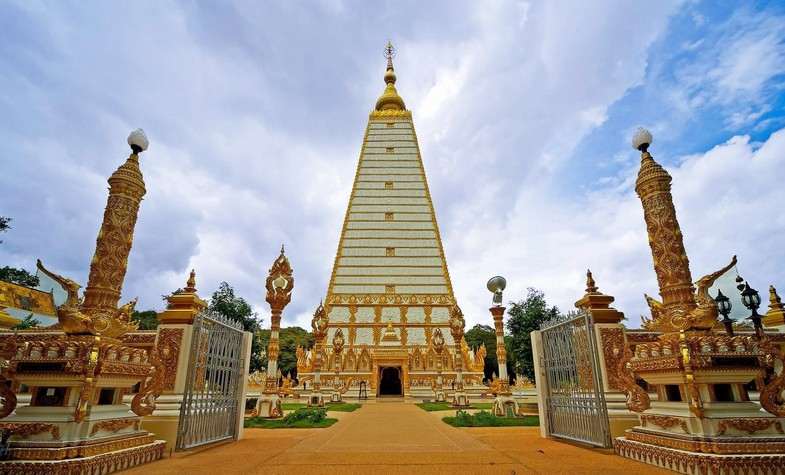
Wat Phra That Nong Bua Temple
Ubonnithat Cultural Exhibition Museum
Address: Th Jaeng Sanit Street. Opening hours: 8h30p - 16h from Monday – Saturday. This museum is not as beautiful as the Ubon Ratchathani Culture and Art Center at Rajabhat University. The museum exhibits much more cultural artifacts than the National Museum. There are a number of notable topics such as the Ubon preaching monks' gallery including their sermons written in English, herbal medicine, music, costumes and sculpture candles.
Pha Taem National Park:
Pha Taem National Park covers an area of about 140 km2, consisting of plains and hills with steep slopes. Most are phytoplankton, and flowers grow on the rocky ground. This is the first sunrise spot in Thailand. In addition, there is a mountain slope where visitors can observe prehistoric rock carvings of about 3,000 - 4,000 years. Do not miss catching Thailand’s first ray of sunlight and discover more than 300 prehistoric cave paintings at Pha Taem National Park.
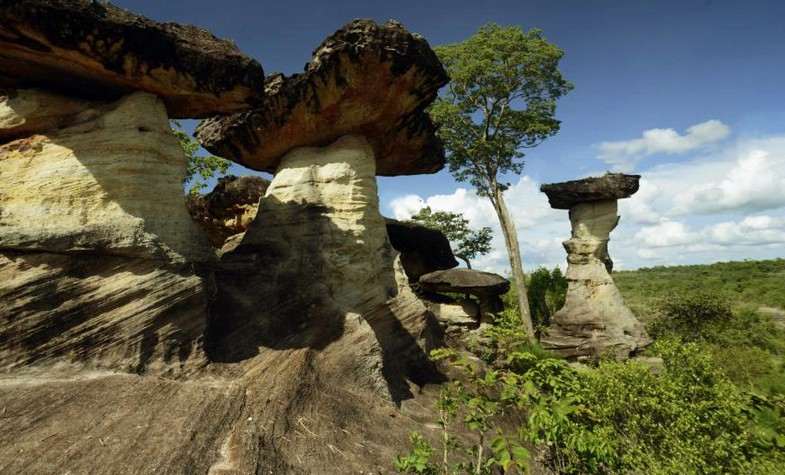
Pha Taem National Park Mushroom Stones
Namtok Huay Luang Waterfall:
Also known as valley waterfall. This is a beautiful and famous waterfall of Ubon Ratchathani province, consisting of three waterfalls flowing from a height of 30 meters down a pit like a valley. There is also white sand and emerald green water, visitors can enjoy the pleasant feeling when visiting the waterfall during the period from September to February each year. By the end of October to December, the natural flowers will bloom on the rocks around the waterfall making a stunning scenery.
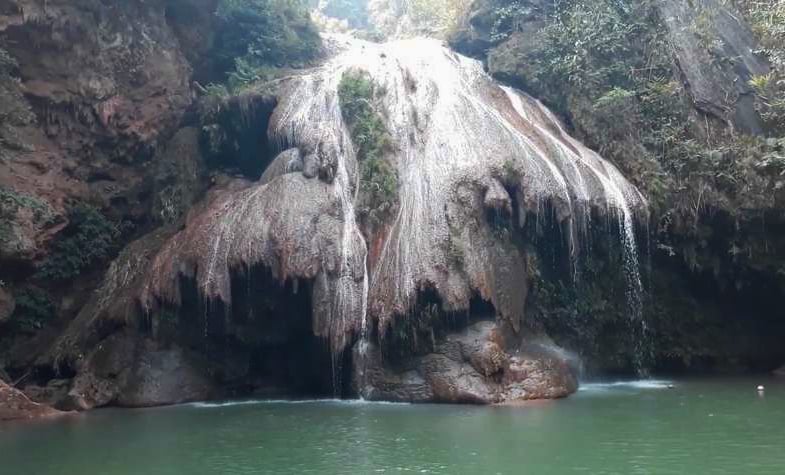
Namtok Huay Luang Waterfall
Sam Phan Bok stone of 3,000 holes
The rocks here when the flood season comes will be submerged in the Mekong River. The rocks were swirled and honed by the flood water, creating different natural shapes. When the dry season comes, the water runs out, and the rocks appear to show off their natural beauty. According to statistics, there are over 3,000 holes in this rocky beach. This is the best destination for your imagination with the shape of the stones. Best time to visit Sam Phan Bok is the dry season. If you choose to go there by a boat, you will be given a bonus view of the Mekong and the rural life along its bank, chase the last light at Had Hong Sand Dunes.

Sam Phan Bok stone
Phu Prao Temple:
Another one that you don’t want to miss out when traveling to Ubon Ratchanthani is seeing the tree of life at Phu Prao Temple. Wat Sirindhorn Wanaram Phu Prao or simply Wat Phu Prao is Dubbed ‘The Glowing Temple’ which is popular with tourists by Tree of Life meticulously carved on the back gate of its chapel. The temple itself is an architectural gem and definitely worth a visit during daytime. While the best time to see the illuminated tree is from 6 to 8 pm. Located hilltop overlooking Laos, the golden Lanchang-style temple offers you not only a feast for the eyes, but also a lung full of fresh mountain air whenever you are in there.
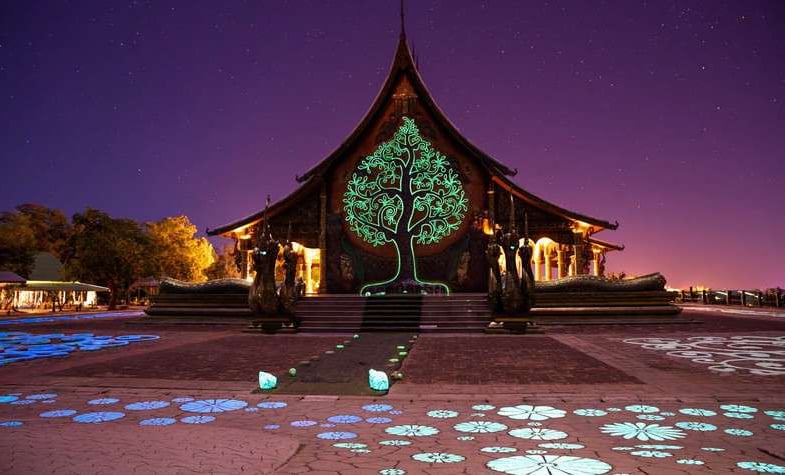
Phu Prao Temple

